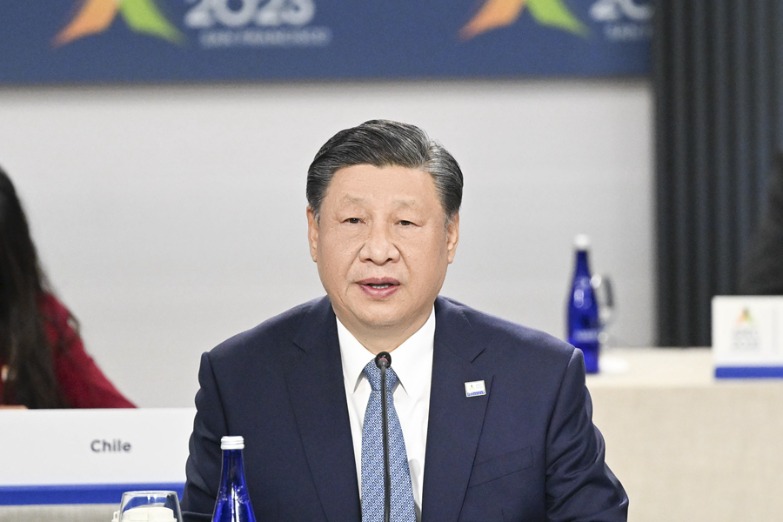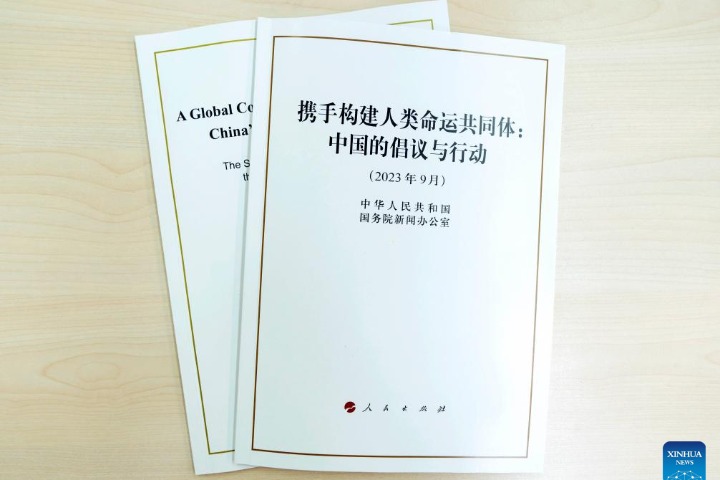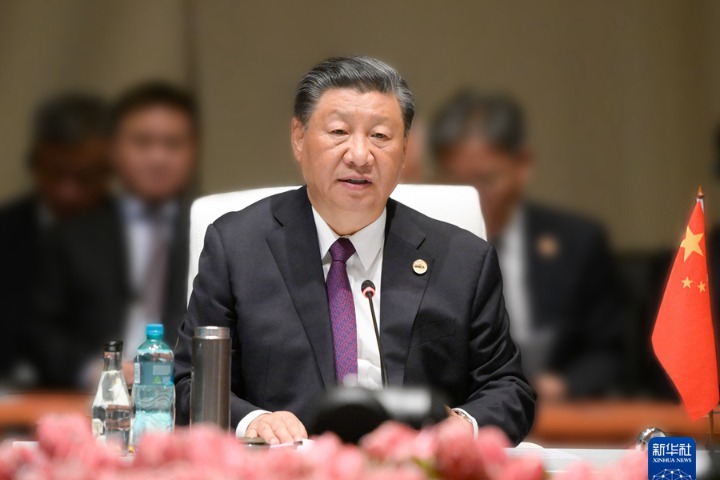中国共产党尊重和保障人权的伟大实践(双语全文)
新华网 2021-06-25 10:01

四、促进各项人权全面发展
IV. Making Comprehensive Progress in Human Rights
中国共产党坚持把保障人民生存权、发展权作为首要的基本人权,坚持在发展中保障和改善民生,以发展促人权,努力推动人权事业全面发展,促进人的全面发展。
The CPC upholds the rights to subsistence and development as the primary and basic human rights, and works hard to ensure and improve people's wellbeing through development. The Party makes every effort to achieve comprehensive progress in human rights and ensure the well-rounded development of all the people.
(一)切实保障人民的生存权
1. Ensuring the Right to Subsistence
经过长期不懈奋斗,中国人民实现了从翻身解放到解决温饱、从基本小康到全面小康,并正在向共同富裕目标迈进。
After a long period of unremitting work, the Chinese people have attained liberation, secured adequate food and clothing, become better off and achieved moderate prosperity in all respects step by step, and they are now heading towards a higher level of common prosperity.
贫困是实现人权的最大障碍。中国持续开展以农村扶贫开发为中心的减贫行动。中共十八大以来,以习近平同志为核心的党中央作出坚决打赢脱贫攻坚战的战略部署,明确目标任务,汇聚全党全国全社会之力打响脱贫攻坚战。经过8年持续奋斗,到2020年底,中国如期完成新时代脱贫攻坚目标任务,现行标准下9899万农村贫困人口全部脱贫,832个贫困县全部摘帽,12.8万个贫困村全部出列,区域性整体贫困得到解决。中国在减贫事业上取得的巨大成就,不仅改写了中国人权事业发展史,也创造了世界人权保障新奇迹,提前10年实现联合国2030年可持续发展议程减贫目标,显著缩小了世界贫困人口的版图,对全球减贫贡献率超过70%。
Poverty is the greatest obstacle to human rights. China has engaged in a huge program of poverty reduction focusing on development-driven poverty alleviation in rural areas. Since the 18th CPC National Congress held in 2012, the central Party leadership with Xi Jinping at the core has made specific plans and set clear goals and tasks for winning the battle against poverty. Resources across the Party and the whole country have been pooled for this battle. After eight years of continuous struggle, at the end of 2020 China achieved the goal of eliminating absolute poverty as scheduled. All the 99 million rural poor living below the current poverty line were raised from poverty, as were all the 832 counties and 128,000 villages classified as poor. Overall regional poverty no longer exists. China’s achievements in this field have written a new chapter in the history of human rights, and created a miracle in the global human rights effort. China is 10 years ahead in its plan to realize the goals of the United Nations 2030 Agenda for Sustainable Development. China’s contribution represents more than 70 percent of the global poverty reduction effort, and has significantly reduced the world’s impoverished population.
人民生活水平大幅提高。1952年、1978年中国国内生产总值分别为679亿元、3679亿元,人均国内生产总值分别为119元、385元。2020年,中国国内生产总值达1015986亿元,突破100万亿元大关,人均国内生产总值72000元,连续两年超过1万美元。1956年和1978年,全国居民人均可支配收入分别为98元和171元,居民人均消费支出分别为88元和151元。2020年,全国居民人均可支配收入32189元,居民人均消费支出21210元。
Living standards have improved. In 1952, China's GDP was RMB67.9 billion and its per capita GDP was RMB119. In 1978, the GDP figure was RMB367.9 billion and the per capita figure was RMB385. In 2020, GDP reached RMB101.6 trillion, and per capita GDP was RMB72,000, more than the threshold of US$10,000 for the second year. In 1956, per capita disposable income of Chinese citizens was RMB98 and per capita consumer spending was RMB88. In 1978, the figures were RMB171 and RMB151. In 2020, per capita disposable income stood at RMB32,189, and per capita consumer spending was RMB21,210.
生命健康权保障水平大幅提升。中国共产党始终坚持卫生事业的公益属性,持续深入推进医药卫生体制改革。中共十八大以来,以习近平同志为核心的党中央强调“把保障人民健康放在优先发展的战略位置”“没有全民健康,就没有全面小康”,作出实施健康中国建设的重大决策。2019年,中国居民平均预期寿命从1949年的35岁提高到77.3岁,孕产妇和婴儿死亡率分别下降到17.8/10万和5.6‰,主要健康指标总体上优于中高收入国家平均水平。妇女儿童生命健康权保障水平大幅提升,被世界卫生组织列为妇幼健康高绩效的10个国家之一。
The rights to life and health are better protected. Treating health services as a matter of public welfare, the CPC has continued to drive deeper reform of the medical and health care system. Since the 18th National Congress of the CPC, the Central Committee has followed two guidelines: “People’s health is a strategic priority for development”, and “Without a healthy population, we will be unable to achieve moderate prosperity”. Based on such understanding, the leadership took a major decision to carry out the Healthy China initiative. In 2019, the life expectancy of Chinese citizens rose to 77.3 years, compared with 35 years in 1949; the maternal and perinatal mortality rate dropped to 17.8 per 100,000; and the infant mortality rate to 5.6 per 1,000. Main health indicators were generally higher than the average level of middle- and high-income countries. The protection of women and children’s rights to life and health has been extended considerably. In this area, China is recognized by the World Health Organization as one of the 10 fast-track countries to MDGs 4 and 5a.
2020年年初以来在全球范围内暴发的新冠肺炎疫情,是百年来人类遭遇的影响范围最大的全球性大流行病,对全世界是一次严重危机和严峻考验。在以习近平同志为核心的党中央坚强领导下,中国坚持人民至上、生命至上,把保障人的生命安全和健康放在第一位。开展新中国成立以来规模最大的医疗支援行动,调动全国医疗资源和力量,全力支持湖北省和武汉市医疗救治。自2020年1月24日至3月8日,全国共调集346支国家医疗队、4.26万名医务人员、900多名公共卫生人员驰援湖北。19个省份以对口支援、以省包市的方式支援湖北省除武汉市以外的16个地市。采取积极、科学、灵活的救治策略,慎终如始、全力以赴救治每一位患者,从出生仅30个小时的婴儿至100多岁的老人,不计代价抢救每一位患者的生命。实施患者免费救治,及时预拨疫情防控资金,确保患者不因费用问题影响就医,确保各地不因资金问题影响医疗救治和疫情防控。一些危重症患者治疗费用几十万元甚至上百万元,全部由国家承担。对本轮新冠肺炎疫苗接种实施全民免费,在受种者知情自愿同意的前提下,疫苗及接种费用由医保基金负担,财政对医保基金给予补助。
At the start of 2020, a Covid-19 epidemic spread in outbreaks all around the world. This is a global pandemic with the largest impact that humanity has encountered in a century, a serious crisis and a daunting challenge for the international community. Under the strong leadership of the CPC Central Committee with Xi Jinping at its core, China has put the people’s interests and their lives and health first – nothing is more precious than people's lives.
Launching the largest medical assistance operation since the founding of the PRC, China mobilized all its medical resources to support the efforts in Wuhan and other locations in Hubei Province. From January 24, Chinese New Year’s Eve, to March 8, it rallied 346 national medical teams, consisting of 42,600 medical workers and more than 900 public health professionals to the immediate aid of Hubei, especially the city of Wuhan. Nineteen provinces and equivalent administrative units assisted 16 other prefectures/cities in Hubei in the form of paired assistance. Employing proactive, science-based, and flexible ways of treatment, the medical workers did everything possible to treat each and every patient, from an infant only 30 hours old to a centenarian. The goal was to save every single victim whatever the cost. The Chinese government provided free treatment for patients. Government funds for Covid-19 control were made available in advance to ensure that they could receive timely treatment and local authorities could proceed smoothly with measures for medical treatment and epidemic control. The individual cost for treating some Covid-19 patients in critical conditions reached hundreds of thousands of yuan, and in some extreme cases even exceeded RMB1 million, all covered by the state.
The current round of Covid-19 vaccination is free to all. With informed and voluntary consent of the recipients, the vaccines and vaccination costs are borne by the medical and health care insurance fund with subsidies from the state budget.
(二)大幅提升经济、社会、文化、环境权利保障水平
2. Ensuring Economic, Social, Cultural, and Environmental Rights
就业是民生之本。中国共产党把促进就业放在经济社会发展的优先位置,坚持就业优先战略和更加积极的就业政策。2020年,在新冠肺炎疫情冲击下,党中央统筹推进疫情防控和经济社会发展,把就业列为“六稳”“六保”之首,推出减负、稳岗、扩就业等一系列政策举措,就业形势逐步回稳向好。2020年末城镇调查失业率为5.2%;全年城镇新增就业人数1186万人,比900万人的预期目标多286万人。
Employment is pivotal to people's wellbeing. The CPC prioritizes employment in economic and social development. It carries out a pro-employment strategy and pursues a more proactive employment policy. In 2020, to compensate for the impact of the Covid-19 epidemic, the CPC Central Committee coordinated epidemic prevention and control with economic and social development. Employment topped the list of measures to stabilize the six fronts (employment, finance, foreign trade, inbound investment, domestic investment, and market expectations), and to guarantee the six priorities (jobs, daily living needs, food and energy, industrial and supply chains, the interests of market players, and the smooth functioning of grassroots government). A series of policies and measures were launched to reduce the burden on businesses, and stabilize and expand employment. As a result, the urban unemployment rate at the end of 2020 stood at 5.2 percent; 11.9 million new urban jobs were created, 2.9 million more than the forecast of 9 million.
中国已经建成了包括养老、医疗保障、社会救助等在内的世界上最大的社会保障体系,覆盖面不断扩大,保障水平不断提高。2020年,基本医疗保险覆盖达13.6亿人,共有城乡低保对象4427万人。截至2021年4月,全国参加基本养老保险人数100961万人。自2016年起,开展长期护理保险制度试点,启动跨省异地就医直接结算,社会保障领域公共服务能力不断提高。
China has put in place the world’s largest social security system, including pensions, medical and health care, and social assistance, expanding coverage and improving protection. In 2020, the basic medical insurance scheme covered 1.36 billion people, and a total of 44.3 million urban and rural residents received subsistence allowances. By April 2021, a little over 1 billion people had subscribed to basic old-age insurance across the country. In 2016, China pioneered a long-term nursing insurance system and launched real-time settlement of patient’s medical expenses for treatment incurred outside the administrative area of insurance registration.
居住和出行条件不断改善。中国城镇居民和农村居民人均住房建筑面积在改革开放之初分别为6.7平方米和8.1平方米,2019年分别增长到39.8平方米和48.9平方米。实施城镇保障性安居工程,帮助约2亿困难群众改善了住房条件,推进农村危房改造,不断改善城市和农村居住条件。截至2020年,全国公路总里程达519.8万公里,为新中国成立初期的64倍,高速公路以16.1万公里通车里程稳居世界之首。农村公路里程达438万公里,建制村通客车率达99.4%,农民群众“出门水泥路、抬脚上客车”成为现实。公共汽电车、轨道交通等城市客运基础设施快速发展,网约车、互联网租赁自行车、分时租赁等新业态新模式不断涌现。全国铁路运营里程达14.6万公里,其中高速铁路运营里程3.8万公里。全国民用航空(颁证)机场达241个。
Living conditions continue to improve. At the start of reform and opening up the per capita floor space of urban residents was only 6.7 sq m and rural residents 8.1 sq m. In 2019, the corresponding figures were 39.8 sq m and 48.9 sq m. Construction projects have been launched to provide affordable housing to urban residents, providing better housing to 200 million poor, and dilapidated rural dwellings have been renovated.
Travel facilities are also improving. At the end of 2020, China’s road network totaled 5.2 million km in length, 64 times of the figure in 1949 when the PRC was founded. China’s figure of 161,000 km of expressways is the highest in the world. The rural road network reached 4.4 million km, and 99.4 percent of administrative villages had bus services, realizing the dream of the rural people to have easy access to public transport. Urban passenger transport services such as buses, trams, and rail transit have developed rapidly. New business models such as online car-hailing, online bicycle rental, and time-share leasing continue to emerge. At the end of 2020, the rail network extended 146,000 km, including 38,000 km of high-speed rail. The country had 241 civil aviation airports.
国民受教育权利得到保障。教育投入大幅增长,办学条件显著改善,办学水平不断提高,农村教育得到加强,教育公平迈出重大步伐。城乡免费义务教育全面实现,2020年,9年义务教育巩固率为95.2%,义务教育普及程度达到世界高收入国家的平均水平。2020年,高中阶段教育毛入学率达91.2%,超过中等偏上收入国家平均水平。职业教育快速发展,高等教育由大众化阶段向普及化阶段迈进,2020年,普通本专科招生967.45万人,研究生教育招生110.66万人。
The right to education is guaranteed. Investment in education has grown substantially; conditions and standards in schools have greatly improved; rural education has been strengthened, and major strides have been made in ensuring equal access to education. Free compulsory education is available across the country. In 2020, the completion rate of the free nine-year compulsory education was 95.2 percent; in this metric China has reached the average of high-income countries. China’s gross enrollment rate in senior secondary education was 91.2 percent, higher than the average of upper-middle-income countries. Vocational education has developed rapidly, and higher education is transitioning from mass access to universal access. In 2020, about 9.7 million undergraduate students and 1.1 million postgraduates enrolled in colleges and universities.
社会主义文化事业全面繁荣,覆盖城乡的公共文化体系逐步建立,公共文化设施逐步实现免费开放。截至2019年,全国共有群众文化机构44073个,其中乡镇综合文化站33530个;全国群众文化机构共有馆办文艺团体8094个;由文化馆(站)指导的群众业余文艺团体44.18万个。全国共有体育场地371.3万个,体育场地面积31亿平方米,人均体育场地面积2.2平方米。公共体育场馆、全民健身中心、体育公园(或配建体育设施的公园)、公共健身设施覆盖率大幅提升。
Socialist cultural undertakings in China are flourishing in every respect. A public cultural service system covering both urban and rural areas is in place, and an increasing number of public cultural facilities are open to the public without charge. In 2019, China had 44,073 public cultural centers, including 33,530 township cultural facilities; the centers hosted 8,094 literary and artistic groups; and the township facilities hosted 441,800 amateur art groups. There were 3.7 million sports venues nationwide covering an area of 3.1 billion sq m, or a per capita area of 2.2 sq m. This represented a significant increase in public sports venues including stadiums, fitness centers, sports parks (or parks with sports facilities), and open fitness facilities.
中国坚持保护环境基本国策,秉持“良好生态环境是最普惠的民生福祉”的民生观,走可持续发展之路。中共十八大以来,坚持“绿水青山就是金山银山”的绿色发展观,将生态文明建设纳入中国特色社会主义“五位一体”总体布局,坚持走生态优先、绿色低碳的发展道路。卫星图像显示,全球从2000年到2017年新增的绿化面积中约1/4来自中国,贡献比例居世界首位。经初步核算,2020年单位国内生产总值二氧化碳排放比2005年下降48.4%,超额完成40%-45%的控制温室气体排放目标。2020年,清洁能源消费量占能源消费总量的比重升至24.3%,较1978年提高17.7个百分点;细颗粒物(PM2.5)未达标地级及以上城市平均浓度相比2015年下降28.8%;全国地表水水质优良(Ⅰ-Ⅲ类)断面比例提高到83.4%,劣V类断面比例下降到0.6%。
China upholds the basic national policy of environmental protection, and follows the path of sustainable development, believing that a good eco-environment is the most inclusive form of public wellbeing. Since the 18th CPC National Congress, the central leadership has adopted the philosophy of green development: “Clear waters and green mountains are invaluable assets.” It has incorporated eco-environmental progress into the Five-sphere Integrated Plan of building socialism with Chinese characteristics together with economic, political, cultural and social progress, and pursues green and low-carbon development with priority given to the eco-environment.
Satellite images show that from 2000 to 2017, China contributed a quarter of the world’s newly forested land, ranking first among all countries. According to preliminary calculations, China’s carbon dioxide emissions per unit of GDP in 2020 were 48.4 percent lower than that in 2005, over-delivering on its greenhouse gas emissions reduction target by 40-45 percent. In 2020, clean energy consumption accounted for 24.3 percent of total energy consumption, a rise of 17.7 percentage points from 1978. The average concentration of fine particulate matter (PM2.5) in cities at or above the prefecture level fell by 28.8 percent compared with 2015; and the proportion of excellent and good quality surface water (I-III) grew to 83.4 percent while that of inferior Class V surface water dropped to 0.6 percent.
(三)协调推进公民权利和政治权利保障
3. Coordinating Protection of Civil and Political Rights
人身权保障不断加强。宪法确认了公民人身权。立法法规定,有关犯罪和刑罚、对公民政治权利的剥夺和限制人身自由的强制措施和处罚、司法制度等事项,只有全国人大及其常委会有权立法。刑法确立罪刑法定原则、平等适用刑法原则、罪刑相适应原则,依法制裁侵犯公民生命、健康、自由等权利的犯罪行为。刑事诉讼法将“尊重和保障人权”写入总则,明确规定无罪推定原则、非法证据排除规则,保护犯罪嫌疑人、被告人和罪犯依法享有的人权。民法典强调人身自由、人格尊严受法律保护,明确规定公民的人身权利受法律保护,任何组织或者个人不得侵犯。行政处罚法、行政强制法等行政法律通过规范行政权保障公民人身权。为更好保障公民的人身自由,中国先后废止了劳动教养和收容教育制度。
Personal rights protection has been strengthened in China. The Constitution states that “the personal freedom of citizens of the PRC shall not be violated.” The Legislation Law stipulates that matters involving criminal offences and penalties, compulsory measures and penalties involving deprivation of a citizen’s political rights or restriction of personal freedom, and the justice system must be governed by laws developed by the National People‘s Congress (NPC) and its Standing Committee. The Criminal Law sets the principles of legality, equality before the law, and punishment fitting the crime. It punishes criminal acts that violate citizens’ rights to life, health, freedom, etc., as provided for by the law. The Criminal Procedure Law states in the General Provisions that respecting and protecting human rights is one of the objectives of this law, and defines the principles of presumption of innocence and exclusionary rule to protect the human rights of criminal suspects, defendants and criminals. The Civil Code states that a natural person’s right to life, life safety and dignity are protected by law and free from infringement by any organization or individual. The Law on Administrative Penalty, the Administrative Compulsion Law and other administrative laws protect the personal rights of citizens by regulating administrative power. China has successively abolished the systems of re-education through labor and of detention education to better protect the personal freedom of its citizens.
选举权受到法律保障。选举权和被选举权是宪法规定的公民基本政治权利,凡年满18周岁的中国公民,不分民族、种族、性别、职业、家庭出身、宗教信仰、教育程度、财产状况、居住期限,除依法被剥夺政治权利的人外,都有选举权和被选举权。中国依据普遍、平等、直接选举和间接选举相结合以及差额选举、秘密投票的原则,依法保障人人享有平等的选举权利,实现城乡按相同人口比例选举人大代表,并保证各地区、各民族、各方面都有适当数量的代表。
The right to vote is guaranteed by law. The right to vote and to stand for election is a basic political right of citizens defined in the Constitution: All citizens who have reached the age of 18 have the right to vote and stand for election, regardless of ethnicity, race, gender, occupation, family background, religious belief, education, property status, or length of residence, except persons deprived of political rights in accordance with the law. The principles of universality, equality, combination of direct and indirect elections, competitive election and secret ballot are applied to ensure equal right to vote for everyone in accordance with the law. The election system ensures that both rural and urban areas are represented by people’s congress deputies in proportion to their population, and that all regions, ethnic groups, and sectors of society have a certain proportion of deputies.
知情权参与权表达权监督权保障体系持续完善。建立健全常态化的法律草案公开征求意见工作机制。截至2021年4月,国家立法机关共有230件次法律草案向社会公开征求意见。民法典草案公开征求意见期间共收到425762人次提出的1021834条意见。大力推行政务公开,以公开为原则,不公开为例外,全面推行权力清单、责任清单、负面清单公开工作,全国均已公布省市县三级政府部门权力清单。健全依法决策机制,在重大行政决策过程中,注重增强公众参与实效,提高专家论证质量,依法保障公民在行政决策中的参与权。不断完善信访制度,依法及时处理信访问题,维护群众合法权益。国家信访信息系统联通了全国31个省(区、市)和新疆生产建设兵团信访部门、42个中央和国家机关,方便群众反映情况、提出建议意见或者投诉请求。建立人民建议征集制度,畅通民意表达渠道,创新群众监督方式。建立便捷高效的网络表达平台,公民在网络上积极建言献策、表达诉求,有序参与社会管理,成为全过程民主的重要渠道。保障公民和社会组织对国家机关和公职人员进行监督的权利。全国人大常委会履行宪法法律监督职责,健全备案审查制度,建立全国统一的备案审查信息平台。
People's rights to know, to be involved, to express views, and to supervise the exercise of power are better protected. A mechanism through which public opinion is consulted in drafting laws has been established and improved. By April 2021, the state legislatures had solicited public opinion on 230 draft laws. A total of 425,762 comments were received for the draft Civil Code alone, collecting 1,021,834 pieces of opinion.
Administrative work of the government has been made more transparent. Following the principle that public disclosure is the rule rather than the exception, a list of well-defined powers, a list of responsibilities and a negative list for governments at different levels have been introduced across the country. The power list for governments at provincial, city and county levels has been published nationwide.
The mechanism in which decisions are made in accordance with the law has been improved, with a focus on the effectiveness of public participation and the quality of expert discussion, so as to protect the citizens’ right to participate in administrative decision-making.
The public complaints reporting system has been steadily improved to ensure problems are handled in a lawful and timely manner, and people’s legitimate rights and interests are protected. The national public complaints information system links the public complaints and proposals departments of all the provincial-level administrative units on the Chinese mainland, and 42 departments of the CPC Central Committee and ministries of the central government. This system makes it easier for people to report information, or raise suggestions, complaints, or requests.
A system to solicit proposals from the public has been set up. China provides smooth channels through which people express their opinions, and offers innovative means of public supervision. It has put in place convenient and effective online platforms for citizens to offer their views and advice, express their demands, and participate in social management in an orderly manner, making such platforms an important channel for realizing whole-process democracy.
Citizens and social organizations have the right to supervise state organs and public functionaries. The NPC Standing Committee performs its constitutional and legal duty of supervision. The system for recording and reviewing regulations, rules and other normative documents has been improved, and a national platform has been set up to this end.
实行宗教信仰自由政策。中国始终坚持从本国国情和宗教实际出发,实行政教分离和宗教信仰自由政策,维护宗教和谐,构建积极健康的宗教关系,尊重和保护公民信仰宗教和不信仰宗教的权利。国家保护正常宗教活动,依法对涉及国家利益和社会公共利益的宗教事务进行管理,但不干涉宗教内部事务。支持各宗教坚持独立自主自办原则,在独立自主、平等友好、互相尊重的基础上开展对外交往。在中国,信教公民和不信教公民相互尊重、和睦相处,积极投身改革开放和社会主义现代化建设,共同为实现中华民族伟大复兴的中国梦贡献力量。
Freedom of religious belief is guaranteed. Based on the realities of the country and the conditions applying to its religions, China follows the policies of separation of government from religion and of freedom of religious belief, maintains religious harmony, builds active and healthy religious relations, and respects and protects the citizens’ right to follow or not to follow any religion. The government protects normal religious activities, and manages religious affairs involving national and public interests but does not interfere in the internal affairs of religions. It supports all religions in upholding the principle of independence and self-management, and in carrying out external exchanges on the basis of independence, equality, friendship, and mutual respect. In China, believers and non-believers respect each other and live in harmony; they work together in China’s reform and opening up and socialist modernization for the realization of the Chinese Dream of national rejuvenation.
(四)全面保障特定群体权利
4. Protecting the Rights of Special Groups in All Respects
坚持各民族一律平等。依法保障各民族群众平等享有管理国家事务的权利。中国通过民族区域自治法、选举法、教育法、国家通用语言文字法、就业促进法等法律法规保障少数民族享有的各项权利。中国55个少数民族均有本民族的全国人大代表和全国政协委员,十三届全国人大代表中少数民族代表438名,占14.7%;十三届全国政协委员中少数民族委员247名,占11.45%。发展民族教育事业,在广大农牧区推行寄宿制教育,举办民族预科班、民族班,着力办好民族地区高等教育,保障少数民族受教育权利。目前,民族地区已全面普及从小学到初中9年义务教育,西藏自治区、新疆维吾尔自治区的南疆地区等实现了从学前到高中阶段15年免费教育。除回族历史上使用汉语,满族、畲族基本转用汉语外,其他52个少数民族都有本民族语言,有20多个少数民族共使用近30种文字。国家依法保障少数民族语言文字在行政管理、司法活动、新闻出版、广播影视、文化教育等各领域的合法使用。
China maintains that all ethnic groups are equal. It ensures that people of all ethnic groups have equal rights to administer state affairs in accordance with the law. China protects the rights of ethnic minority groups through the Law on Regional Ethnic Autonomy, the Electoral Law for the National People’s Congress and Local People’s Congresses, the Education Law, the Law on the Standard Spoken and Written Chinese Language, the Employment Promotion Law, and other relevant laws and regulations.
All 55 ethnic minority groups have deputies at the NPC and members in the National Committee of the Chinese People's Political Consultative Conference (CPPCC). The 13th NPC has 438 deputies from ethnic minority groups, accounting for 14.7 percent of the total, and the 13th CPPCC National Committee has 247 members from ethnic minority groups, making up 11.5 percent of the total.
China has invested a significant effort in ethnic minority education. It works to ensure their right to education by running boarding schools in farming and pastoral areas, opening preparatory courses and special classes for ethnic minorities at colleges and schools, and prioritizing ethnic minority areas in developing higher education. Nine-year compulsory education (elementary and junior high schools) is universal in ethnic minority areas. In Tibet Autonomous Region and south Xinjiang Uygur Autonomous Region, students are exempt from charges for education for a total of 15 years from preschool to senior high school.
With the exception of the Hui, who have used Han Chinese historically, and the Manchu and She peoples who now generally use Han Chinese, the other 52 ethnic minorities have their own spoken languages, and over 20 groups use nearly 30 written scripts. The Chinese government protects by law the legitimate use of the spoken and written languages of ethnic minorities in the areas of administration and judicature, press and publishing, radio, film and television, and culture and education.
中国建立了包括100多部法律法规在内的全面保障妇女儿童权益的法律体系,先后制定实施了3个周期的妇女、儿童发展纲要,有力推动了妇女儿童事业与经济社会协调发展。制定专门法律,预防和制止家庭暴力,保护家庭成员的合法权益。多次修改完善刑法和刑事诉讼法,加强对未成年人的保护,严厉打击侵害未成年人的犯罪行为,健全涉罪未成年人的特殊保护制度。截至2021年4月,全国共有少年法庭1800余个,未成年人检察机构1500余个,未成年人检察机构检察官4400余名。
China has put in place a legal system of more than 100 laws and regulations that comprehensively protects the rights and interests of women and children. It has enacted three guidelines on women’s development and three on children’s development, coordinating protection of women and children with economic and social development.
China promulgated a special law to prevent and stop domestic violence and protect the legal rights of family members.
The Criminal Law and the Criminal Procedure Law have been amended many times to strengthen the protection of minors. Robust action has been taken against criminal acts against minors, and the system of special protection for minors involved in crimes has been improved. In April 2021, there were more than 1,800 juvenile courts, and more than 1,500 juvenile prosecuting organs with more than 4,400 prosecutors.
尊老敬老是中华民族的传统美德。多次修订完善老年人权益保障法,31个省(区、市)制定了配套地方性法规,切实保障老年人合法权益。2019年11月,中共中央、国务院印发《国家积极应对人口老龄化中长期规划》,进一步加强对老年人权益保障机制的顶层设计。经济困难的高龄、失能等老年人补贴制度实现省级全覆盖,积极构建老年健康服务体系。截至2021年3月,中国已有33万余个养老服务机构和设施,817.2万张养老服务床位;1477万老年人纳入城乡低保,383.8万老年人纳入特困人员救助供养,3290.2万老年人享受高龄、护理等不同类型的老年补贴。
Respecting the elderly is a traditional virtue of the Chinese culture. The Law on the Protection of the Rights and Interests of the Elderly has been formulated and amended a number of times, while regional regulations were made in 31 provinces and equivalent administrative units to protect the legitimate rights and interests of the elderly. In November 2019, the CPC Central Committee and the State Council issued the Medium and Long-term Plan for Proactive National Response to Population Aging, strengthening the top-level framework for protecting the rights and interests of the elderly.
All provincial-level administrative units on the Chinese mainland have adopted the subsidy system for elderly people experiencing economic difficulties or suffering from disabilities. China is building a health service system for the elderly. In March 2021, China had more than 330,000 institutions and facilities with 8.2 million beds to provide services to the elderly. 14.8 million senior citizens received subsistence allowances; 3.8 million received assistance and support for people in extreme difficulty; 32.9 million received advanced age subsidies, nursing subsidies, and other old-age subsidies.
残疾人权利保障不断加强。截至2021年4月,直接保护残疾人权益的法律有90多部,行政法规有50多部。全面建立困难残疾人生活补贴和重度残疾人护理补贴制度,截至2020年,有1212.6万困难残疾人享受了生活补贴,1473.8万重度残疾人享受了护理补贴。实现家庭经济困难的残疾学生12年免费教育,北京、辽宁、江苏、西藏、新疆等省(区、市)实现残疾学生15年免费教育。国家为残疾人提供职业培训和就业服务,截至2020年,累计有631.4万残疾人接受了职业技能培训。大力支持无障碍环境建设,积极推进康复辅助器具产业发展,建立实施残疾儿童康复救助制度,不断完善低收入重度残疾人社会化照护服务体系。加快发展精神障碍社区康复服务,推进精神卫生福利机构建设。
Protection of the rights of persons with disabilities has been strengthened. By April 2021, China had more than 90 laws and more than 50 administrative regulations on protection of the rights and interests of this group. China has established a subsidy system to provide living expenses for disabled persons in need and to pay the nursing costs of persons with severe disabilities. By 2020, this system had benefited 12.1 million of the former and 14.7 million of the latter.
China provides 12-year free education for disabled students with financial difficulties; 15-year free education for such students has been realized in Beijing, Liaoning, Jiangsu, Tibet, Xinjiang and some other provinces and equivalent administrative units. The government provides vocational training and employment services for persons with disabilities. By 2020, 6.3 million people with disabilities had received vocational skills training.
China gives strong support to creating an accessible environment, and developing the industry of assistive appliances for rehabilitation. It has established and implemented a rehabilitation and assistance system for children with disabilities, and made constant efforts to improve social care services for low-income people with severe disabilities. It is moving faster to develop community rehabilitation services for mental disorders, and to build mental health welfare institutions.

















 英语点津微信
英语点津微信 双语小程序
双语小程序